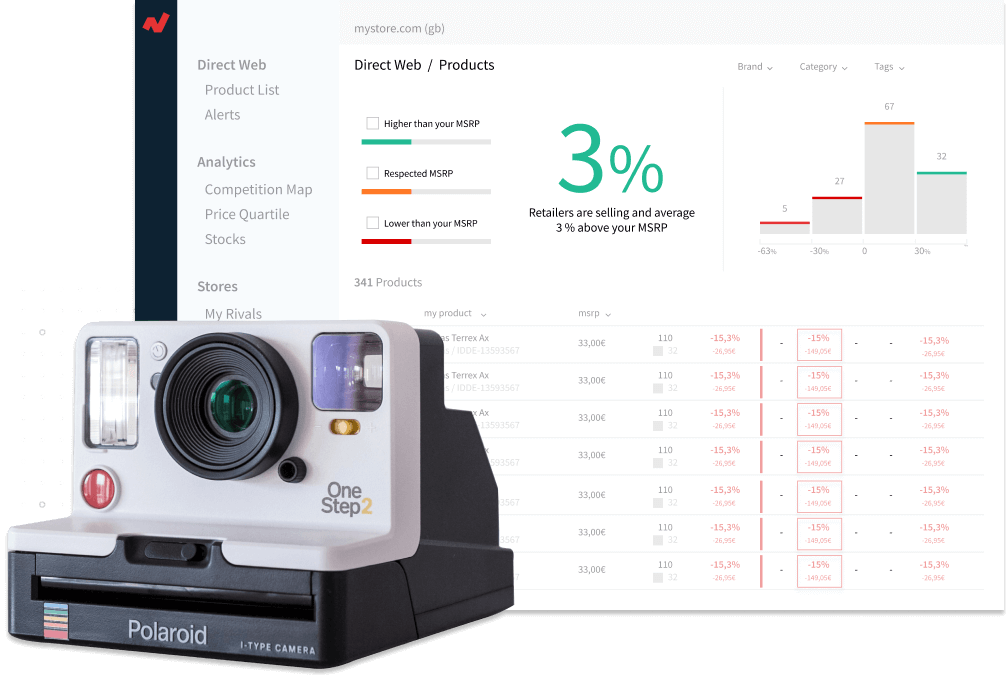Brands and online retailers have two distinct contexts, although the current competitive scenario and the strategic evolution of online sales have had a direct impact on both. Retailers, on the one hand, are continually looking for ways to improve their conversions, while brands are largely concerned with product positioning and consumer perception. This last point is what has led brands to develop strategies based on price monitoring and review tracking of their products in the market.
In an attempt to gain a competitive advantage, online stores decide to use negotiation to achieve conditions that allow them to adjust their margins. But where does that leave brands? The dilemma for brands is how far they can protect their prices, as well as the performance and distribution of their products. For this reason, many of them consider the monitoring of prices and opinions as a way to get a better view of what happens to their products in the market and thus be able to make better and more justified decisions to safeguard the profitability and image of their products.
At this point, we could establish that there are two essential areas in any market research conducted by brands and that are the basis for their strategic changes: opinions and prices.
Visualize the positioning of your products through competitive tracking
One of the most influential elements in the purchase decision is the price and this, in turn, impacts directly on the perception that the customer has of the product.
This is relevant for several reasons. In a highly competitive environment, price will always be one of the main reasons for discarding or choosing a product. Most users today turn to large platforms such as Amazon to perform their initial search: first of all, they will select the department and category to which the type of product they are looking for belongs, and then it is very likely that they will decide to sort the results based on ratings, reviews or prices.
In certain occasions, users will base their decision strictly on the price, without caring too much if the product itself offers the best features of the market, since their purchase depends on a limited budget. At the other extreme, you will find those users who base their purchasing decisions on the prestige of a product or even the prestige of the brand as a whole. These are items with very high performance and have gained a reputation within the industry for the quality or sense of luxury they convey. On the other hand, and as an intermediate and more common situation, there will be those customers who base their purchasing decisions on the price, ratings, reviews and features of the product. This last type of user is someone who is always looking for the best value for money.
These are the aspects that make it essential for brands to have a good vision of the positioning of their products in the market. The ideal is to clearly establish which online stores sell items within the price ranges contemplated and contrast at the same time, how the product is received by the target audience. However, getting and keeping track of this type of data can be a daunting task and involves a waste of resources, both time and money.
In this sense, there are solutions in the market that allow to automatically track prices, ratings and reviews of specific products across several websites. In the case of prices, this type of platforms are particularly useful when tracking web prices to detect minimum prices and they also offer the possibility of creating price alerts to be informed about price fluctuations in the market at the time when these changes occur. In short, it is a set of data that allows brands to easily analyze the state of the market and the pricing situation in which their brand articles are.
Determining customers’ perception of the product by monitoring opinions
By tracking ratings and reviews , brands have the possibility to determine how a product or a particular product line are perceived from the customers’ perspective.
Undoubtedly, this type of assessment is very useful for both detecting strengths and weaknesses in your brand’s product range. If you get a better understanding of what the consumer thinks, you will have options to improve the characteristics or performance of your products. In addition, if you extend this type of analysis to competing products, you will have the necessary information to know to what extent your articles match or exceed them, or even if some of their features should be modified to achieve a better level of competitiveness.
To conclude, we could confirm that in such a changing online landscape, the key to success lies in having the right tools. The use of solutions that automatically track and test prices, as well as other aspects that affect the perception of the product such as ratings and reviews, will be crucial for the maintenance, improvement and greater acceptance of your branding.





